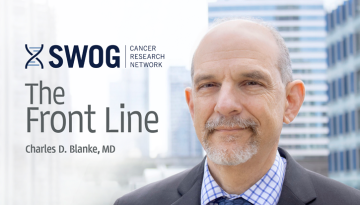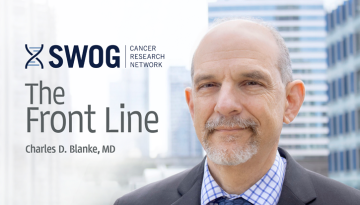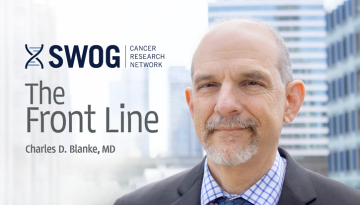SWOG Trial Results Trifecta
We use the term “innovate” quite a bit in cancer research – so much so that it can sound clichéd. But making things better by trying something new is what we do routinely at SWOG. And I’ve got not one but three recent examples to prove it. All are textbook examples of ingenuity in cancer clinical trials. Let’s walk through them:
- Dr. Priyanka Sharma, our new breast committee vice chair and a physician at University of Kansas Cancer Center, led a team that (in a good way) raided our biospecimen bank. Her team used 20-year-old tumor samples, gathered as part of S9313, which itself assessed the effectiveness of adjuvant doxorubicin and cyclophosphamide chemotherapy. The trial closed in 1997, but the SWOG team used assays that show HRD status could be a biomarker for AC chemotherapy success. As Dr. Sharma says in the press release on the results: “Banking tissue in cancer research is a smart investment. Tissue collected for one research study can be used for others, creating value for patients, investigators, and for the public who funds our SWOG research.”
- Dr. Joe Unger, one of our most engaged and productive biostatisticians, led a team that also just published results last week in the Journal of the National Cancer Institute. Unger and his team found that men who take the medication finasteride get a prostate cancer prevention benefit that can last 16 years – twice as long as previously recorded. His finding was made possible by a new research strategy – linking Medicare claims data to clinical trial data, in this case from our landmark Prostate Cancer Prevention Trial, or PCPT. Dr. Unger and his frequent collaborator, Dr. Dawn Hershman, are building an impressive portfolio of trials that regularly use these secondary data sources at SWOG, and they are making us proud. Read about their JNCI results in the press release.
- Dr. Tony Shields, along with Alliance collaborators Drs. Axel Grothey and Jeffrey Meyerhardt, this week published the first paper from the IDEA collaboration in the New England Journal of Medicine. Talk about innovation! This trial remains unique in its design and global scope – enrolling 12,834 eligible patients in six consolidated phase III trials run in parallel in 12 countries in North America, Europe, and Asia. The trial’s findings show that some stage III colon cancer patients can safely eliminate half of their adjuvant chemotherapy – results that made a huge splash at ASCO and ESMO last year. And they’ve already changed practice. Read about the new guidelines, and the NEJM paper (which has an accompanying editorial by Dr. Richard Schilsky) in the press release.
What I especially love about these results is that they’re not only examples of innovation today. They, in fact, reflect smart, fresh thinking arising long ago.
We can thank Dr. Hannah Linden, the principal investigator of S9313, for banking her trial specimens back in the 1990s. We can thank Dr. Ian Thompson for leading the PCPT – which created its own biorepository and trove of trial data. And we can thank the late Dr. Dan Sargent, the Alliance group statistician who conceived of IDEA. His brilliance still shines. These pioneers, and today’s, have my respect and gratitude. They have clearly helped us in our mission to aid those touched, or potentially touched, by cancer.
Other Recent Stories



